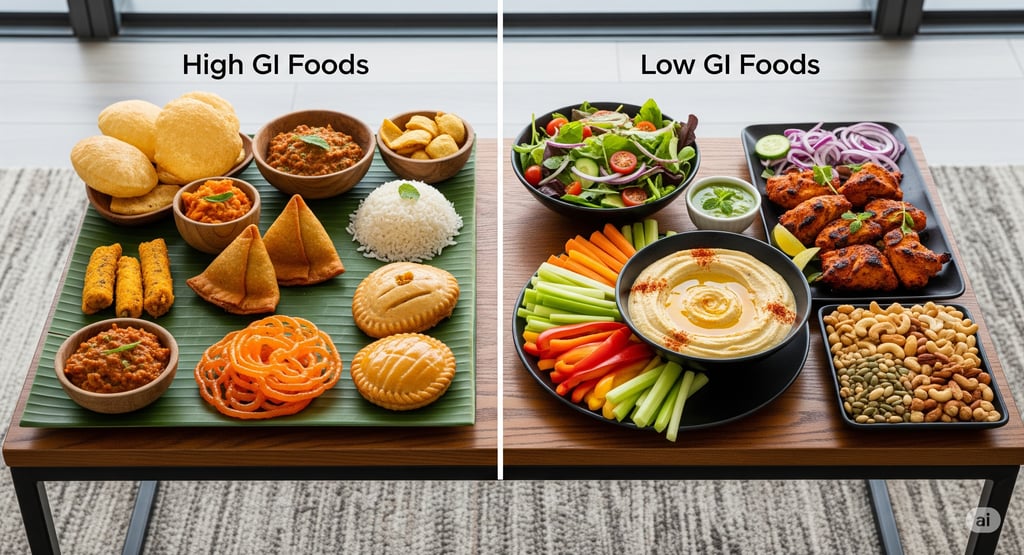Unlocking the Secret to Stable Energy: Understanding Glycemic Index (GI)
Trulo Team
8/15/20254 min read


Welcome to the Trulo family! We're passionate about empowering you to make informed choices about your food, not just for today, but for a healthier, more balanced tomorrow. At the heart of our philosophy lies a concept that’s gaining significant traction in the world of nutrition: the Glycemic Index (GI).
You might have heard whispers about it, or perhaps you’re actively looking for ways to manage your blood sugar. Whatever your level of familiarity, this comprehensive guide will break down the science of GI and why it’s a cornerstone of the Trulo approach to food.
India's Metabolic Landscape: A Call for Smarter Eating
Living in India, we’re increasingly aware of the growing metabolic health challenges. With a significant population living with diabetes and even more in the prediabetes zone, understanding how our food impacts our bodies is crucial. Blood sugar spikes, often triggered by the foods we eat, are not just linked to diabetes but can also contribute to weight gain, hormonal imbalances, fatigue, and even affect our mood and focus.
While "no sugar" and "high protein" have become popular buzzwords, Trulo believes in a more nuanced and holistic approach: glycemic control. This is where the Glycemic Index comes into play.
So, What Exactly is the Glycemic Index (GI)?
Think of GI as a ranking system for carbohydrate-containing foods. It tells you how quickly each food causes a rise in your blood sugar levels after you eat it. The GI scale ranges from 0 to 100, with pure glucose (a type of sugar) having a GI of 100.
High GI (70 or more): These foods are rapidly digested and absorbed, leading to a quick and often significant spike in blood sugar. Examples include white bread, white rice, sugary drinks, and potatoes.
Medium GI (56 to 69): These foods cause a moderate rise in blood sugar levels. Examples include whole wheat bread, brown rice, and sweet potatoes.
Low GI (55 or less): These foods are digested and absorbed more slowly, resulting in a gradual and gentler rise in blood sugar. Examples include most fruits, non-starchy vegetables, legumes, and whole grains like millets.
The Science Behind the Spikes: How Our Bodies Process Carbohydrates
When we eat carbohydrates, our digestive system breaks them down into glucose, which then enters our bloodstream. Our pancreas releases insulin, a hormone that helps glucose move from the blood into our cells for energy.
High-GI foods flood the bloodstream with glucose quickly. This triggers a rapid release of insulin. Sometimes, this can lead to a sharp drop in blood sugar shortly after the initial spike, leaving you feeling tired, hungry, and craving more high-GI foods – a vicious cycle. Over time, frequent spikes and crashes can strain your pancreas and contribute to insulin resistance.
Low-GI foods, on the other hand, release glucose into the bloodstream gradually. This provides a steady and sustained source of energy, preventing drastic insulin surges and subsequent blood sugar dips.
Why Should You Care About GI? The Benefits of Low-GI Eating
Choosing low-GI foods can have a profound impact on your overall health and well-being:
Stable Blood Sugar Levels: This is the most direct benefit, crucial for individuals with diabetes or prediabetes, but also beneficial for anyone wanting to maintain consistent energy and prevent energy crashes.
Improved Weight Management: Low-GI foods tend to be more satiating due to their higher fiber content and slower digestion. This can help you feel fuller for longer, reducing overall calorie intake and aiding in weight management.
Enhanced Energy Levels: Say goodbye to afternoon slumps! Stable blood sugar provides a consistent fuel supply for your body and brain, leading to sustained energy throughout the day.
Better Mood and Focus: Fluctuations in blood sugar can impact your mood and concentration. A low-GI diet can contribute to more stable moods and improved cognitive function.
Reduced Risk of Chronic Diseases: Long-term consumption of a low-GI diet has been linked to a reduced risk of developing type 2 diabetes, heart disease, and certain types of cancer.
Support for Hormonal Balance: For conditions like PCOS (Polycystic Ovary Syndrome), managing blood sugar through a low-GI diet can be a significant factor in regulating hormones.
Making Low-GI Choices: Practical Tips
Embarking on a low-GI journey doesn't require a complete overhaul of your diet. Here are some simple swaps and additions you can make:
Choose Whole Grains: Opt for whole wheat flour, millets (like jowar, bajra, ragi), brown rice, and quinoa over refined grains like white flour and white rice.
Load Up on Non-Starchy Vegetables: These are naturally low in GI and packed with nutrients and fiber. Include plenty of leafy greens, broccoli, cauliflower, bell peppers, and more in your meals.
Enjoy Fruits in Moderation: While most fruits have a lower GI than processed foods, be mindful of portion sizes. Berries, apples, pears, and citrus fruits are generally good choices.
Include Legumes and Pulses: Lentils, beans, and chickpeas are excellent sources of protein and fiber, and they have a low GI.
Choose Lean Protein Sources: Protein helps slow down the absorption of carbohydrates. Include sources like chicken, fish, tofu, and eggs in your meals.
Healthy Fats are Your Friends: Fats also help slow down digestion. Incorporate sources like avocados, nuts, seeds, and olive oil into your diet.
Be Mindful of Portion Sizes: Even low-GI foods can impact blood sugar if consumed in large quantities.
Consider Combining Foods: Eating high-GI foods with protein, fiber, and healthy fats can help lower the overall glycemic impact of the meal.
Stay tuned for more informative articles, recipes, and product updates from the Trulo team!
